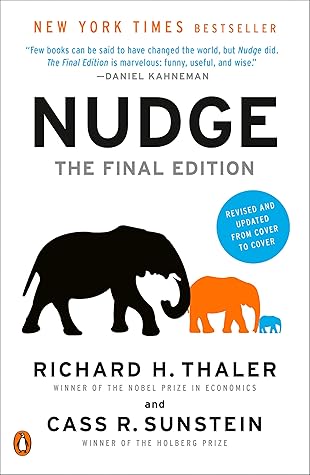More on this book
Community
Kindle Notes & Highlights
Carolyn is what we call a choice architect. A choice architect has the responsibility for organizing the context in which people make decisions.
crucial parallel is that there is no such thing as a “neutral” design.
If you look at economics textbooks, you will learn that Homo economicus can think like Albert Einstein, store as much memory as Google does in the cloud, and exercise the willpower of Mahatma Gandhi.
Their early work identified three common rules of thumb or heuristics—anchoring, availability, and representativeness—and
Similarly, temptation is easier to recognize than to define.
As a result, our behavior reflects a certain naivete about the effects that context can have on choice.
confidence heuristic: people tend to think that confident speakers must be correct.
Even when enough fresh subjects were introduced and others retired so that all the participants were new to the situation, the original group judgment tended to stick,
groups to stick to established patterns even as new needs arise.
social pressures nudge people to accept some pretty odd conclusions—and
and those conclusions might well affect their behavior.
if people wrongly think that most people are committed to a long-standing social norm, a small nudge correcting that misperception can inaugurate large-scale change.
A voluminous body of research finds that informing people about the social norm can be extremely effective.
we usually get feedback only on the options we select, not the ones we reject.
Long-term processes rarely provide good feedback. Someone can eat a high-fat diet for years without having any strong warning
When feedback is ineffective, we may benefit from a nudge.
The discussion thus far suggests that people may most need a good nudge for choices that require memory or have delayed effects; those that are difficult, are infrequent, and offer poor feedback; and those for which the relationship between choice and experience is ambiguous.
We should always be suspicious of miracles.
There is a general lesson here. Much of the time, more money can made by catering to human frailties than by helping people to avoid them.
So, if Humans have problems, they might benefit from a well-chosen nudge.
If you want to encourage people to do something, Make It Easy. If you’re so inclined, hum it to the tune of the old Eagles song: “Take It Easy.”
When choice is complicated and difficult, people might greatly appreciate a sensible default. It
Second, required choosing is often more appropriate for simple yes-or-no decisions than it is for more complex choices.
“elimination by aspects.”
Social science research reveals that as the choices become more numerous or vary on more dimensions, people are more likely to adopt simplifying strategies.
it’s good to nudge people in directions that they might not have specifically chosen in advance.
In this system, patients receive health care services that are often chosen by their physicians and (for most people) paid for by an insurance company or government.
the United States has the most expensive health care system in the world, with only mediocre health care outcomes.
Whenever we can make some activity seem like play, pique our curiosity, or build excitement or anticipation, we will find that people are not only willing to undertake that activity; they even may be willing to pay for the opportunity!
Perhaps the most basic principle of good choice architecture is our mantra: Make It Easy.
figure out why people aren’t doing it already, and eliminate the barriers that are standing in their way.
if you want to discourage some behavior, make it harder by creating barriers.
Some choice architects intentionally impose sludge, inserting friction into a process in order to achieve goals of their own.
Some forms of sludge, particularly common in government settings, have come to be called red tape.


